Ask Us About: Automotive EMC Test Equipment Rentals
Transient Specialists
Filters
Recent Views
Automotive EMC Test Equipment Rentals

Automotive testing immunity testing is commonly done to ISO 7637-2 and ISO 16750-2 pulses, the most common are shown above. Equipment for generating these pulses can either be done with a modular system, as with the EM Test series of equipment, or as a all-in-one systems as with the Teseq NSG 5500. All of our automotive test system rentals include current ISO 17025 calibrations, software, and technical support, helping to lessen the learning curve and complete testing effectively.
Commonly emissions testing is done in accordance with CISPR 25 as well as some associated testing to ISO 7637-2. Typically, emissions test is done both conducted and radiated, involving a measuring EMI receiver to monitoring the associated DUT levels in comparison to allowed tolerances. This is commonly done with a few different antennas for radiated and may require several AN/LISNs for conducted.
We offer several options for conducted emissions including solutions for Rhode & Schwarz, Teseq, Schwarzbeck, and many others. We provide rental equipment for a short as a week, allowing customer to complete testing and limit unnecessary rental fees.
RF amplifiers are a crucial element in radiated immunity testing for automotive applications which often times require higher V/m field strength requirements. The most common of the vechile based requirements ISO 11451-2 (for full vehicle testing) and ISO 11452-2 (for component level testing) can span from 10 kHz up to 18 GHz.
As a leader in EMC and EMI test equipment we have a variety of different amplifiers from 10 KHz to 18 GHz making us an ideal resource for supplemental equipment or short-term requirements. We carry many of top manufacturers including Teseq, Milmega, and Amplifier Research as well as a variety of signal generators, antennas, and many others.
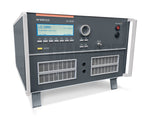
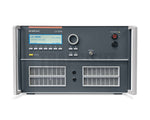
- Generators Clipped Load Dump Pulses
- Tests to ISO 7637-2 & ISO 16750-2 Load Dump
- Built-in CDN Max 80 Volts 30 Amps


- Includes NSG 5500, PA 5840, & CDN 400
- ISO 7637-2 & ISO 7637-3 Tests
- Battery Simulators up to 60 V 100 A
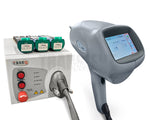
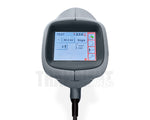
- 30 kV Air & Contact Discharge (100V Steps)
- Rechargeable Battery Powered ESD Simulator
- Charge Removal Feature Capabilities
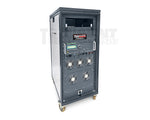
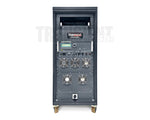
- -60 to +60 Volts 50 Amps Continuous
- Pulses 4 and 2b (ISO 7637-2/ISO 16750-2)
- Extended Range 80 Volts 40 Amps
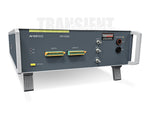
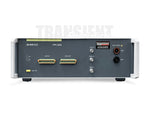
- Switch for Power Lines 100 A and Data Lines 2 A
- Fast Switch with Rise/Fall Times of 200ns
- Pulses E10 and E13 of the LV 124/LV 148
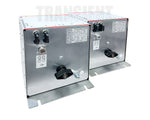
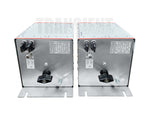
- Max 1000 V/150 A DC or 500 V/150 A AC
- HV Compliant to ISO 7637-4 & CISPR 25
- Jumpers Provide LISN Path Configuration
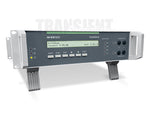

- 2-channel Arbitrary Waveform Generator
- Dual-Processor-Technology, 500kS/s sample rate
- Library of Standard Test Routines


- Pulses 4 and 2b (ISO 7637-2/ISO 16750-2)
- Maximum 60 Voltage 15 Amps
- Voltage Drop Simulator with Low Output Impedance
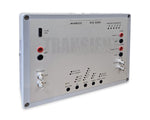
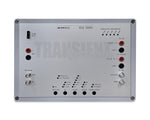
- Compliant Pulses to FMC1278 & EMC-CS-2009.1
- Pulses CI 220: A1, A2-1, A2-2, C-1 and C-2
- Pulses RI 130: A2-1, A2-2 with Coupling Test Fixture
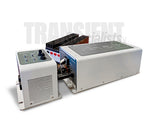
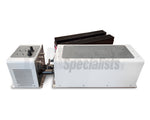
- Electronic Switch, Artificial Network, & RS-Box
- BS 200N100 Electronic switch, 60V DC/100A
- AN 200N100 1,000V DC, 250V AC (up to 1kHz)
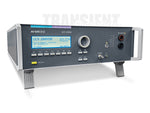
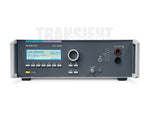
- Micropulse Generator for ISO, JASO, & SAE
- ISO 7637-2 Pulses 1, 2a, 3a, & 3b
- Built-in CDN Max 80 Volts 50 Amps
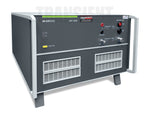
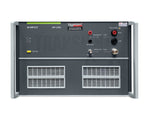
- Output Max. 160 V p-p, 50 V rms
- Output Current Max. 18 A rms
- Automatic Closed Loop Test Procedures
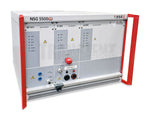
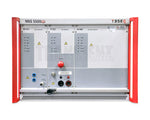
- Test System for ISO 7637-2/3 Requirements
- Battery Simulators Available up to 100 Amps
- Pre-programmed International & OEM Tests
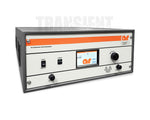
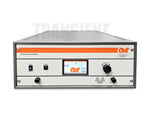
- 80 MHz - 1 GHz 250 Watts Psat (min)
- 200 Watts Power P1dB (min)
- Class A Broadband Amplifier
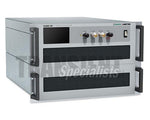

- 800 MHz - 6 GHz 250 Watts Psat (min)
- 200 Watts Power P1dB (min)
- Class A Operation & Front Panel Display
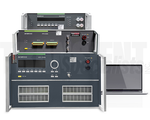
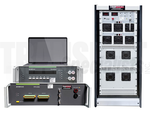
- Provides LV124 E-01 to E-15 Pulses
- DUT Capabilities up to 100 Amps
- Includes Software & Verification Kits
61 products
What is EMI EMC testing for automotive?
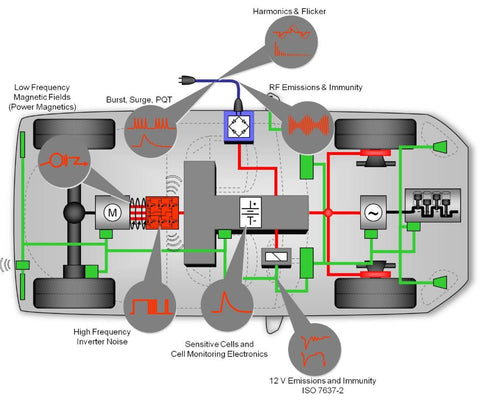
EMI and EMC testing for automotive applications are a series of immunity and emissions tests designed to ensure that equipment doesn't interfere and can operate in the anticipated electrical environment.
While in the automotive industry OEM standards play a large role, there are a few common international requirements commonly used for EMC and EMI testing. These tests commonly include or are referenced:
- Conducted Immunity - ISO 7637-2 & ISO 16750-2
- Conducted Emissions - CISPR 25 & ISO 7637-2
- Radiated Immunity - ISO 11451-2 & ISO 11452-2
- Radiated Emissions - CISPR 25
Why is EMC important in the automotive industry?
EMC is important in the automotive industry for compliance and product reliability given the vast amount of electrical products in a confined space.
Unlike other applications where products or equipment are generally isolated by distance, commonly only connected through low voltage power grid, automotive components and electriconics are in a closely confined space often sharing a common ground. While many automotive tests are unique to the industry given the design of vechiles (load dump, superimposed AC voltages, etc.) some test are similair to this in the commerical industry.
Automotive EMC/EMI Tests
General Testing Information
Automotive electromagnetic compatibility and interference testing for vehicles differs from commercial based testing by the large role company based standards play rather than international standards. However, many of these manufacturer standards reference the more common international standards and require specific modifications/adjustments to requirements.
Conducted Immunity
Transients - Commonly based upon ISO 7637-2/ISO 16750-2 Pulses
ISO 7637-2/-3 Pulses
- Pulse 1: A simulation of transients due to supply disconnection from inductive loads; it applies to a DUT if as used in the vehicle, it remains connected directly in parallel with an inductive load.
- Pulse 2a: Simulates transients due to sudden interruption of currents in a device connected in parallel with the DUT due to the inductances of the wiring harness.
- Pulse 2b: Simulates transients from DC motors acting as generators after the ignition is switched off.
- Pulse 3a/3b: Occurs as the result of switching processes. The characteristics of this pulse are influenced by distributed capacitance and inductance of the wiring harness.
ISO 16750-2 Pulses (Including Load Dump)
- Pulse 4: The voltage reduction caused by energizing the starter motor circuits of the internal combustion engines.
- Pulse 5: Simulation of a load dump transient occurring in the event of a discharged battery being disconnected while the alternator is generating charging current with other loads remaining on the alternator circuit at this moment.

Electrostatic Discharge (ESD) - Based on ISO 10605
Requires different resistance capacitance networks and test levels then are commonly used (150pF/300Ohm) by IEC 61000-4-2:
- 150pF/2kOhm
- 330pF/2kOhm
- 330pF/330Ohm
Equipment
We carry EMI EMC test equipment manufactured by EM Test and Teseq, including the NSG5500 and LD200N, VDS200N, and UCS200N. They provide equipment that generates load dump, fast transients, and power variations tests required by ISO 7637-2, ISO 16750, SAE J1113 and other generic standards. They are also compliant with many manufacturer's standards, including BMW, Ford, GMW 3097, Chrysler, and Nissan. The EM Test automotive EMI test units are unique, because they can be used separately, or they can be connected and used for the complete series of ISO 7637 tests, with the UCS 200n50 used as the central coupler/decoupler. We also rent Automotive Battery Simulators and Load Dump Generators to facilitate testing to many international and manufacturer standards.
Transient Specialists
Filters










